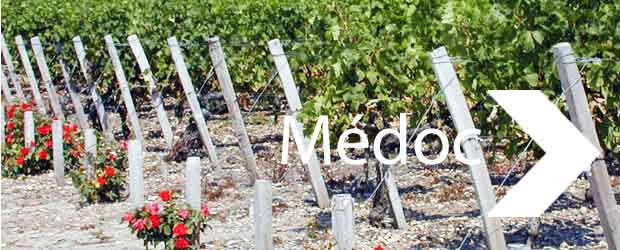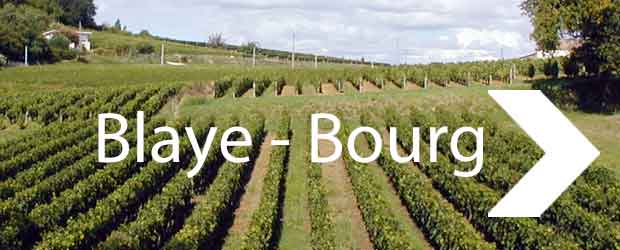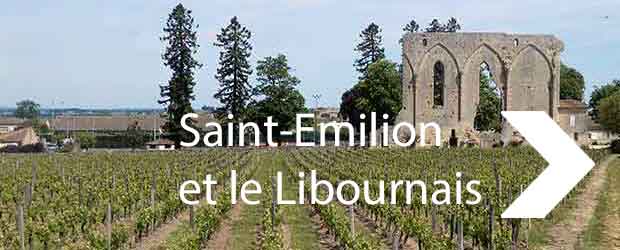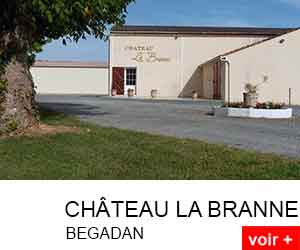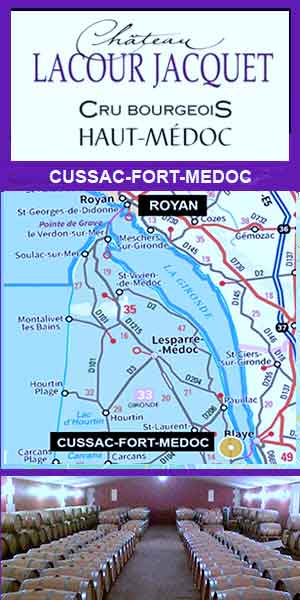THE VINEYARD OF BORDEAUX
VINS.WINE / the vineyard of Bordeaux
Discover the 2020 Classification of the Crus Bourgeois du Médoc
 The 2020 Crus Bourgeois du Médoc Classification was officially published on February 2nd. 2020.
The 2020 Crus Bourgeois du Médoc Classification was officially published on February 2nd. 2020.
The previous ranking was published in 2003.
The 2020 classification is valid for five years and it will concern the 2018, 2019, 2020, 2021 and 2022 vintages.
The new classification introduces an internal hierarchy with three levels:
- cru bourgeois
- cru bourgeois supérieur
- cru bourgeois exceptionnel
The Bordeaux vineyard, the largest quality vineyard in France
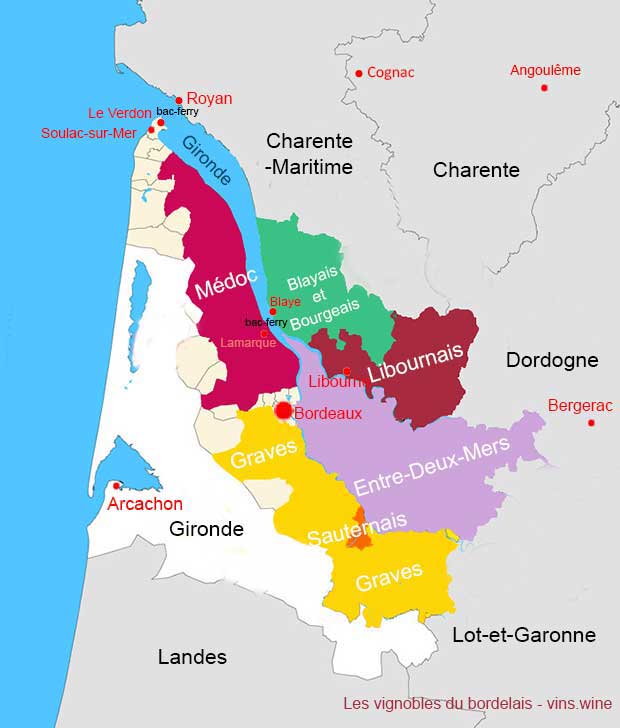
Map of Bordeaux vineyards
Bordeaux wines are famous all over the world. Margaux, Pauillac, Saint-Estèphe, Saint-Julien, Moulis, Listrac, Médoc, Graves, Saint-Emilion, Pomerol, Sauternes,...,names that sing, but also dozens of more discreet names to discover absolutely, Côtes de Blaye, Côtes de Bourg, Fronsac, Côtes de Bordeaux, Bordeaux et Bordeaux Supérieur...
Everyone finds pleasure in the exceptional diversity of Bordeaux, red, white, clairet and rosé wines.
The Bordeaux vineyard in figures
Some characteristic figures of the Bordeaux vineyard, for information:
more than 5,000 "châteaux"
113,000 hectares of vineyards (Burgundy 25,000 hectares)
production of 5.5 million hectoliters
60,000 jobs, direct and indirect, for the entire wine industry
Wine Tourism in Medoc
The Médoc, in the geographic sense, a peninsula between the Atlantic Ocean on the West and the estuary of the Gironde in the East, is different from the Médoc wine appellation, a narrow strip of land between the estuary and the forest, about 80 kilometres long and from 5 to 10 kilometres wide.
Wine Tourism in Blaye Côtes de Bordeaux and Côtes de Bourg
Blaye Côtes de Bordeaux and Côtes de Bourg, opposite the Medoc on the right bank of the Gironde.
> Wine Tourism in Blaye Côtes de Bordeaux and Côtes de Bourg
Saint-Emilion and the Libournais vineyard
Wine Tourism in Saint-Emilion and Libournais vineyard
The fascinating history of the Bordeaux vineyard
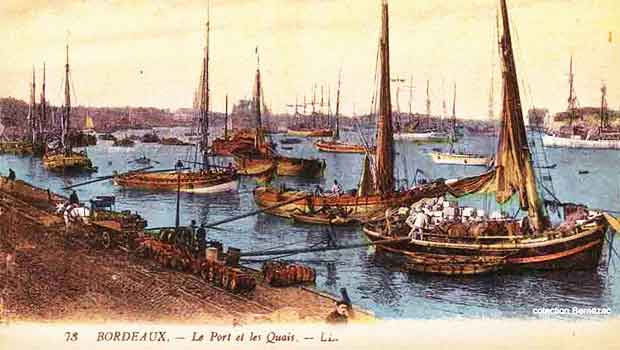
The origins and history of the Bordeaux vineyard. The birth of the vineyard, the Gallo-Roman period, the Middle Ages, Eleanor of Aquitaine, the privilege of 1241, the 18th century, ...
How did the Bordeaux vineyard come about?
In the first century BC, it was the conquest of Gaul (58 - 52 BC) by Julius Caesar.
The development of the vineyards followed the Roman invasion, axis of the Rhône and Saône valleys, axis of Narbonne to Bordeaux and La Rochelle.
There was little wine produced in Gaul. The traditional drink of the Gauls was cervoise, barley or wheat beer.
Historians tell us that the Gauls love wine and are heavy drinkers. They even drink pure wine while the Romans add water.
Gaul becomes an important market for the wines of Italy and the merchants leave with slaves in exchange.
Then the Gallic vineyard develops and the Gauls drink local wine.
At the end of the 1st century AD, a little more than a century after the conquest of Gaul by Julius Caesar, there is a vineyard around Bordeaux, which corresponds to the immediate surroundings of the town of Burdigala, a vineyard which today corresponds now called Graves.
This vineyard is linked to the presence of the port which allows the export of wine.
The Romans' conquest of England developed the export of wine from Bordeaux.
In 91 AD, under the Domitian Emperor, the Romans prohibited the cultivation of vines in Gaul. The land is better for wheat.
In 296, the emperor PROBIUS issued a decree which allowed wine to be made again.
The poet Ausone (4th century) testifies that in his time, there was a vineyard in his city of Bordeaux.
What became of the Bordeaux vineyards during the early Middle Age?
The invasions and troubles of the High Middle Age annihilate the vineyard. The culture of the vine and the know-how are preserved in the monasteries and near the episcopal cities, this is the case of Bordeaux.
What does the Bordeaux vineyard owe to Aliénor d'Aquitaine?
Everything, are we tried to answer. In 1152 in Bordeaux, Aliénor of Aquitaine, divorced from the king of France Louis VII, wife the future king of England Henri Plantagenêt, who becomes King of England in 1154. Aquitaine becomes a province English. From this major date for the Bordelais, 1152, the marriage of Eleanor of Aquitaine to Henri Plantagenêt puts Aquitaine in the kingdom Anglo-Angevin.
For the wine of Bordeaux is a wonderful consequence, the wine of Bordeaux, which had already started selling in England, finds a much easier outlet there and England becomes the main market. The wine of Bordeaux, from that time, took very strongly the way of the Atlantic, the English Channel and Europe north and not at all the way to Paris, and all that for political, sentimental and economic reasons.
The Bordeaux vineyards, from the Middle Ages, from the 12th century, is a vineyard that is completely turned to export.
The English, very importers of wine, very amateurs, develop the vineyard. For three centuries any peasant can cultivate the vine in Aquitaine. The boom is considerable until 1453, battle of Castillon, end of the 100 years war. Aquitaine returns to France.
We are told that at that time, a million hectoliters of wine left Bordeaux for England and the countries of the North Sea, 85% of Bordeaux production.
The English give the name "claret" to Bordeaux wine (we have today a Bordeaux Clairet appellation).

Guide Œnotourisme
Bordeaux
Charentes-Cognac
Bordeaux
- Le vignoble de Bordeaux
- Appellations, Cépages
- Les vins, vinification et élevage
- Bordeaux,petite histoire du vignoble
- Oenotourisme Médoc
- Les Crus Bourgeois du Médoc
- Les Crus Artisans du Médoc
- Oenotourisme Blaye et Bourg
- Oenotourisme Saint-Emilion Libournais
- Bordeaux et Bordeaux Supérieur
- Bordeaux, Cité du Vin
- Le Concours Bordeaux - Vins d'Aquitaine
- Bordeaux, visite découverte
Charentes-Cognac
- Le vignoble Cognac Charentes
- Le cognac
- Le pineau
- Les vins charentais IGP
- Cognac, visite découverte
- Jarnac, visite découverte
Visites et dégustation
- Adresses Oenotourisme
- Nos adresses dans le Médoc
- Nos adresses Blaye et Bourg
- Nos adresses Cognac Charentes
- Domaine Gardrat, Cozes, Charente-Maritime
- La dégustation des vins
- Acheter à la Propriété
- Acheter en ligne direct Producteurs
La vigne et le vin
- La vigne, de la taille aux vendanges
- Les engrais verts dans la culture de la vigne
- les vins, vinification et élevage
- Le vin et la Bande Dessinée
